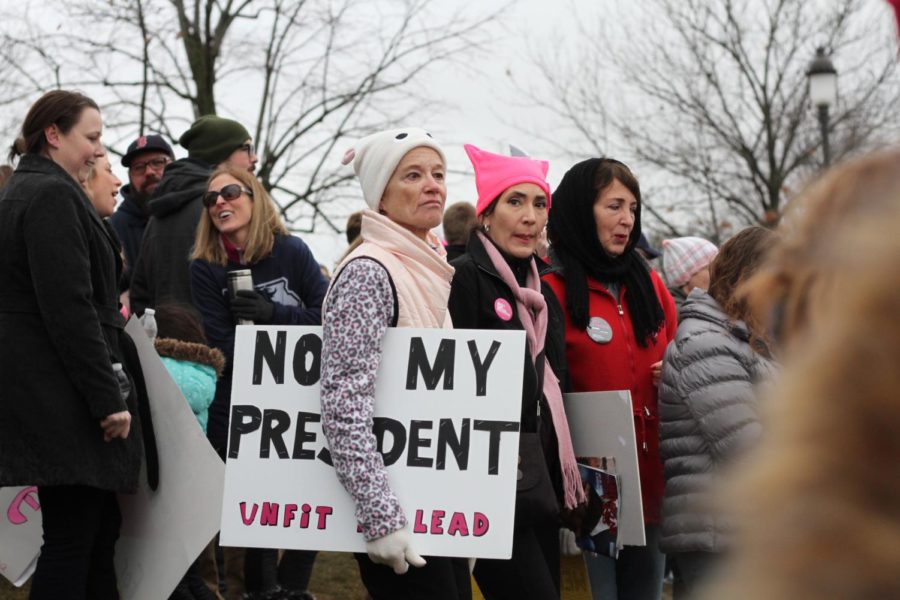- App Content
- App Content / News
- News
- News / Nation
- News / Politics And Administration / State
- News / State
- News / Student Life
Women’s marches first step in generating a larger political movement
A protester holds a sign that reads, “Not my president, unfit to lead,” during the Women’s March in Des Moines on Saturday. Thousands circled the Iowa State Capitol to raise awareness for women’s issues.
January 29, 2017
Over a million people participated in women’s marches Jan. 21 after President Donald Trump’s inauguration. Globally, others joined in. Numbers ranged from 100,000 in London to 30 in Antarctica.
Early projections show an estimated 2.5 million people gathered for women’s marches across the globe.
In Des Moines alone, 25,000 attendees were reported.
“There are a large number of people that are not happy with the outcome of the election,” said Kelly Winfrey, assistant professor in the Greenlee School of Journalism and Communication. “More importantly, with the things that Trump has said about women and the stances he’s taken on policies related to women.”
The marches demonstrate a unity around opposition as women, Winfrey said.
“Much like in other times in history with the women’s movement […] women are uniting around a common cause that’s based on their gender,” Winfrey said. “It’s not something we’ve seen a lot […] in the past 30 years or so because […] a lot of the big issues have been addressed in legislation.”
For Natalie Weathers, junior in communication studies, that unity was felt Jan. 21 when she attended the women’s march in Des Moines.
“[The march] was very empowering […] I was not expecting the number of people that came out to support [women’s rights,]” Weathers said.
Weathers said she was apprehensive because of the fact that Iowa was a red state. When she showed up, however, she was overwhelmed by the smiles on peoples’ faces, the signs that people had and the way they greeted one another.
“It was a genuine sense of peace and comfort at this time,” Weathers said. “I mean, the inauguration that happened the day before […] to come and be among thousands of people who had the same beliefs as you […] it brought so much hope.”
Amy Bix, professor of history, said there are some interesting historical comparisons that suffragists faced in 1913, when Woodrow Wilson became president.
“There’s kind of a story that, in those days, the incoming President Wilson arrived in [Washington, D.C.,] by train and he looked around and there weren’t any crowds,” Bix said. “And he said, ‘Where is everybody?’ And somebody said, ‘They’re all off at the women’s march.’”
Bix said the story can be taken with a grain of salt, as it may or may not be true — but it does parallel a narrative seen with Trump’s inauguration crowd and the response calling for women’s rights.
“Marches can demonstrate to people that there are others like them […] that can be mobilizing,” Winfrey said. “The problem is that sometimes marches are just marches.”
There is one question moving forward, Winfrey said.
“Is this a one-off thing, where there was a march and then nothing happens afterward […] or does this start a larger political discussion and movement to address the issues that were underlying the march in the first place?”
Bix agreed that one day is impressive and great symbolically, but in the end to make a real change, the movement needs to be sustained.
“These next four years are such unknowns, I think,” Bix said. “For women activists, I’d hope [that they use] this as an opportunity to reach across generation … to share perspective, to share experiences and to think collectively about ‘what’s the best strategy for moving forward?’”
For Weathers, going forward, influencing the Senate and local government is the next logical step. For others feeling overwhelmed, Weathers suggested they take care of themselves and the support they need.
“I know there are different communities right now that may feel like everyone is against them — I would say specifically Trump supporters and even some religious organizations — but one thing I want to say is … right now is not the time to think about our individual identities but to focus on the identities of others and those who need support,” Weathers said.
The marcher encouraged others not to look past themselves, but perhaps inwardly instead.
“That does not mean you deny your own morals and deny who you are […] just show love and support to people,” Weathers said.
It could be said, perhaps, that for the 2.5 million people globally, love and support was what Jan. 21 was all about.







